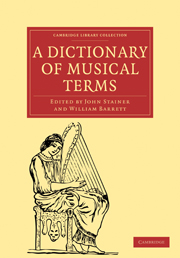A
Published online by Cambridge University Press: 10 November 2010
Summary
A.(1) The note called Proslambanomenos in the greater perfect System of the Greeks. The letter-name of Mese, the highest note of the middle tetrachord; and of Nete, the highest note of the upper tetrachord. [Greek Music]
—(2) The first note of (1) the Hypo-Dorian mode, or church-scale, commencing four notes below the Dorian; (2) the Hyper-Phrygian mode, or church-scale, commencing four notes above the Phrygian; (3) the Eolian mode. [Greek Music]
—(3) The next note above Gamma Ut, in the Grave Hexachord of the Guidonian system, where it is A re. Also, the first note of the acute and super-acute Hexachords, in which it is a la mi re. [Notation.]
—(4) The normal minor scale of modern music, so-called because it is the relative minor of C. It is sometimes also named the natural minor scale, because no sharps or flats are required in its signature.
—(5) The normal sound (Ger. Normalton), because the instruments of an orchestra tune to this note, as given by the Oboe or Organ.
—(6) The key-note of the major scale, which has three sharps for its signature.
—(7) The name given to a string tuned to the sound A. The A-string of a violin is its second string; of a viola, its first string; of a violoncello, its first string; but on this instrument it is one octave lower in pitch than the A-string of a violin or viola; of a Double-Bass, its third string, which is two octaves lower in pitch than the first string of a violoncello; of a guitar, its sixth string.
- Type
- Chapter
- Information
- A Dictionary of Musical Terms , pp. 1 - 41Publisher: Cambridge University PressPrint publication year: 2009First published in: 1876



